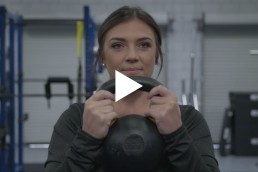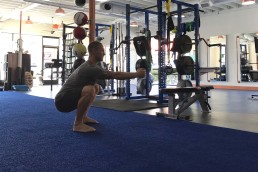First off I’d like to thank all of you that reached out to me with positive feedback regarding the first blog post. I’ve really struggled to find the motivation to start doing this as I genuinely figured nobody would read or be interested in what I might have to say. So thanks once again!
This week we’ll be going more in-depth with tip #2 from last week: Microdosing. It can be defined as the practice of performing small amounts of training in order to physiologically benefit from it, while minimizing undesirable side effects. I think it’s important to point out that if I were to remove “small amounts of” from that sentence, I would be describing my thoughts on training in general. Far too often it seems people (I’ve certainly been guilty of this in the past) throw caution to the wind when training in regard to volume, variety, and “cool stuff they saw on instagram”, which often maximizes undesirable effects such as fatigue and soreness. We then convince ourselves that these are indicators of “grinding’ and “getting after it”, when in fact they’re signs of overtraining that in the long run can be detrimental to performance and even cause injury. I could bang on all day regarding this so probably best I get off the tangent and back to microsdosing.
Microdosing training seems to be a reasonably new idea in this field, but in reality it’s just good training done in the minimal amount of time possible. It is the minimal effective dose of training, whereas a regular training session would normally be the maximum, non-detrimental dose. Keep in mind this is only going to work if you are training really often – I’d say 5+ times a week. If you are working out 2-3 times a week and only putting in 30-minute sessions, your chances of maintain strength and peak performance throughout the year are slim to none.
One last thing I want to touch on before diving in to the structure of your micro sessions is your daily routine. This is going to be the subject of the next blog post, so I won’t go into too much detail right now. Hopefully I spoke to most of you in the off-season about creating a daily routine of myofascial and mobility/stability exercises that not only keep your tissues moving well, but act as a daily self-assessment. If you are doing this 10-minute routine daily it will greatly reduce what you need to achieve in your workout and give you more time to focus on strength work. On many occasions, your daily routine may be your only training for the day, particularly minor league travel days.
HOW TO DESIGN YOUR MICRODOSE TRAINING SESSIONS
1. Prioritize movements that have direct carryover to your on field movements.
If you’re a catcher, squat variations will have great carryover, whereas if you’re a pitcher not so much. So take a couple of minutes to think about what you’re asking your body to do on the field, what positions are you getting in and out of, and then what exercises will likely help with that. There are some obvious staples that will have huge benefit for everybody such as; hinging, core stability / segmentation, hip internal and external rotation, and posterior cuff activation / strengthening.
You should also consider what areas you tend to struggle in such as hip internal rotation, glute activation, shoulder ball in socket congruency etc. Several of the pitchers worked extensively on internal rotation and eccentric control of the hamstring on their front leg. Many guys came back with limited thoracic extension and insanely tight / over active lats. If addressed daily, all of these things can be managed.
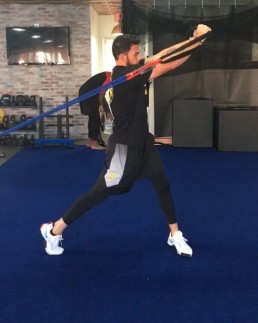
Big Joe working some diagonal chops
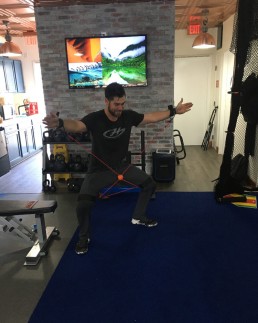
Must be a catchers drill….Austin
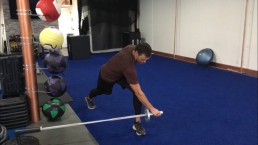
Parker on the Landmine Pitcher Deceleration
B. Utilize supersets, compound sets, and mini circuits.
To save on time and energy, you can easily group exercises together for several different reasons. Supersets aim to provide contrast and are used regularly in our training. I personally like to use them by pairing movements together that won’t affect recovery of each other, and, as a bonus, compliment each other. For example, supersetting a Trap Bar Deadlift with a ½ Kneeling BUKB SA Press. While the Deadlift is predominantly taxing the posterior chain particularly in the lower body, it is also holding your lats down in a shortened position. So while recovering between sets, your upper body and anterior core should have plenty of energy in order to perform the press, which in turn will force the lats to lengthen and allow the scapular to upwardly rotate on the rib cage.
Compound sets are movements that focus on similar areas of the body. For example, a KB Swing set with a Broad Jump would be a compound set hoping to make use of post activation potentiation. Pairing an anti-extension exercise, such as TRX Fall Outs, with a Sumo Deadlift would both challenge the anterior core, which with appropriate rest periods can be very affective for you if you tend to spend a lot time in extension.
Mini Circuits are 3 or more exercises performed back to back with little rest between for multiple rounds. Between rounds you will have a prolonged rest period. I think these are pretty self-explanatory and give you a ton of freedom to design different routines. If you have more questions, however, let me know.
EXAMPLES:
30MIN SESSION
| MOVEMENT PREP | SETS | REPS | REST |
|---|---|---|---|
| A. Segmented Cat / Cow | 1 | 4 | – |
| A. Sphinx T-Spine Rotation | 1 | 5e | – |
| A. Toe Grab Squat to Stand | 1 | 5 | – |
| A. Prone I to Cuff | 1 | 10 | – |
| LIFT | SETS | REPS | REST |
| B. DB Split Squat | 2 | 8e | 30sec |
| B. Straight Leg Glute Bridge March | 2 | 20sec | – |
| B. Dead Bug | 2 | 10e | 60sec |
| C. BB RDL | 2 | 8 | 30sec |
| C. Yoga Push Up | 2 | 12 | 30sec |
| C. Bird Dog on Bench 1 Arm Row | 2 | 10e | 60sec |
45MIN SESSION
| MOVEMENT PREP | SETS | REPS | REST |
|---|---|---|---|
| A. Global Spine CAR | 1 | 3 | – |
| A. Rear Foot Elevated Hip Flexor Rock | 1 | 5e | – |
| A. Quadruped Hip CAR | 1 | 2e | – |
| A. Quadruped Glenohumeral CAR | 1 | 2e | – |
| A. 2 to 1 Leg Drop Squat | 1 | 5e | – |
| LIFT | SETS | REPS | REST |
| B. KB Swing | 2 | 12 | – |
| B. SL Bowler Squat | 2 | 10e | 60sec |
| C. Trap Bar Deadlift | 4 | 2 | 30sec |
| C. Inclined Bench DB Row | 3 | 5 | 60sec |
| D. ½ Kneeling Landmine Press | 3 | 6e | 30sec |
| D. RB Shoulder External Rotation | 2 | 15e | 60sec |
These are merely examples to give shape to what we’re discussing, as mentioned in the last blog post please take the time to include things that you enjoy, your body responds well to, and areas that were of emphasis for you during the offseason.
Jono Green
Co-Founder of Symbiotic Training Center
Jono is a Certified Strength and Conditioning Specialist through the National Strength and Conditioning Association with over a decade of experience training high-level athletes. Specializing in baseball performance, Jono has trained over 20 professional baseball athletes, including 3 World Series Champion Houston Astros players.
The Importance Of In-Season Strength Training For Pitchers
In the softball community, there seems to be some confusion about both the value of strength training and the value of strength training in season. For me, it’s very clear: DO BOTH.
Creating a Daily Routine
Since training in season and keeping your body feeling healthy can be so difficult, it’s important to have a daily routine. Something that will keep your body moving and feeling better, but also act as a daily self assessment.
Why Practicing More isn’t the Answer
What if pitching more isn’t the answer to getting better? I know that sounds absurd, right? Everyone knows practice makes us better…. but does it?


